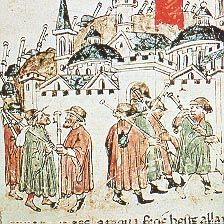(Rivista Internazionale - December 1996: The Pilgrim's Routes and the Order of Malta - 1/2)
History
The Pilgrim's Routes and the Order of Malta
by Paolo Caucci von Saucken
Born in Palestine to assist and defend pilgrims, the Order of St. John of Jerusalem's
vocation
rapidly expanded to cover not only those coming to the Holy Land but all those making a Pilgrimage to one of the major sanctuaries of Christendom.
Both J.
Riley Smith and A. Luttrell have pointed out how in 1113, the year in which Paschal II formally recognised it, the Order was already running hospices in Asti, near the Alpine passes, and in the Ports of Pisa, Bari,
Otranto, Taranto and Messina. Just as the seats of the four Italian Priories were situated in the crucial points of contact between Italy and the Holy Land: Venice, Pisa, Barletta and Messina.
It is therefore evident that the expansion of the Order of St. John in the west, in
what from the perspective of Jerusalem and Rhodes was called ultramare, favoured the communication routes, ports, passes and road junctions. This was not only to ease the passage of those directed to the
places where the Order's
activity was concentrated,
but also to implement its natural vocation for assistance to Pilgrims,
addressed to the great Masses of people in continuous movement towards the holy places Christendom.
 |
Pilgrims during the Jubilee in 1300. Miniatures from "Cronica" (Scarambi, Ms. 107). |
To see the relationship between the Order of Malta and the pilgrim's routes and to assess the meaning and value of the great pilgrimage season expected for the end of this millennium, we must first of all establish what exactly the medieval pilgrim's route was, how it was organised, what its characteristics were and, above all, how we can reconstruct it for our times.
Besides pointing out historical and archaeological elements of the pilgrims' routes, we will also indicate useful factors for the Roman jubilee of 2000.
There are different criteria for defining a pilgrims' route. First of all, this route must end in an important sacred place. The first consideration is that the itinerary must be functional for achieving the goal that constitutes its constant point of reference, and which guides and gives meaning to
everything that happens along it.
The route leading to the shrine or the sacred place often takes their name: so we have the vie lauretane, via micaeliche and vie romee. The most famous example of this is the Camino de Santiago, which despite being also a trade and military route, takes its name from its more specific function, that of
conducting pilgrims to the tomb of the Apostle James found in Galitiae in the furthest part of the
medieval known world, in occasum mundi, or in finibus terrae, as we read in medieval texts.
next page
back to summary